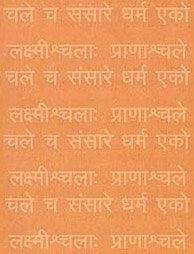Mahamoha, Mahāmoha, Maha-moha: 7 definitions
Introduction:
Mahamoha means something in Hinduism, Sanskrit. If you want to know the exact meaning, history, etymology or English translation of this term then check out the descriptions on this page. Add your comment or reference to a book if you want to contribute to this summary article.
In Hinduism
Samkhya (school of philosophy)
Source: Wisdom Library: Sāṃkhya philosophyMahāmoha (महामोह, “the great delusion”) is the third type of viparyaya (ignorance), according to the Sāṃkhya theory of evolution. Viparyaya refers to a category of pratyayasarga (intellectual products), which represents the first of two types of sarga (products) that come into being during tattvapariṇāma (elemental manifestations), which in turn, evolve out of the two types of pariṇāma (change, modification).

Samkhya (सांख्य, Sāṃkhya) is a dualistic school of Hindu philosophy (astika) and is closeley related to the Yoga school. Samkhya philosophy accepts three pramanas (‘proofs’) only as valid means of gaining knowledge. Another important concept is their theory of evolution, revolving around prakriti (matter) and purusha (consciousness).
Purana and Itihasa (epic history)
Source: Shodhganga: The saurapurana - a critical studyMahāmoha (महामोह) refers to one of the five Avidyās, according to the 10th century Saurapurāṇa: one of the various Upapurāṇas depicting Śaivism.—When Brahmā meditates there is creation of five types of avidyā known as creation predominated by tamas (prādurbhūtaḥ tamomoyaḥ). This avidyā is spoken of as fivefold—tamas, moha, mahāmoha, tāmisra and andhatāmisra. After the creation of this five fold avidyā Brahmā again meditates as, a result of which the world of vegetation is produced. This is termed as mukhyasarga. It is the fourth in order (“mukhyā nagā iti proktā mukhya sargastu sa smṛtaḥ”).

The Purana (पुराण, purāṇas) refers to Sanskrit literature preserving ancient India’s vast cultural history, including historical legends, religious ceremonies, various arts and sciences. The eighteen mahapuranas total over 400,000 shlokas (metrical couplets) and date to at least several centuries BCE.
Languages of India and abroad
Sanskrit dictionary
Source: DDSA: The practical Sanskrit-English dictionaryMahāmoha (महामोह).—great infatuation or confusion of mind. (sasarja) महामोहं च मोहं च तमश्चाज्ञानवृत्तयः (mahāmohaṃ ca mohaṃ ca tamaścājñānavṛttayaḥ) Bhāgavata 3.12.2.
-hā an epithet of Durgā.
Derivable forms: mahāmohaḥ (महामोहः).
Mahāmoha is a Sanskrit compound consisting of the terms mahā and moha (मोह).
Source: Cologne Digital Sanskrit Dictionaries: Monier-Williams Sanskrit-English Dictionary1) Mahāmoha (महामोह):—[=mahā-moha] [from mahā > mah] m. great confusion or infatuation of mind, [Purāṇa; Rājataraṅgiṇī] etc.
2) Mahāmohā (महामोहा):—[=mahā-mohā] [from mahā-moha > mahā > mah] f. Name of Durgā, [Mārkaṇḍeya-purāṇa]
[Sanskrit to German]
Sanskrit, also spelled संस्कृतम् (saṃskṛtam), is an ancient language of India commonly seen as the grandmother of the Indo-European language family (even English!). Closely allied with Prakrit and Pali, Sanskrit is more exhaustive in both grammar and terms and has the most extensive collection of literature in the world, greatly surpassing its sister-languages Greek and Latin.
Kannada-English dictionary
Source: Alar: Kannada-English corpusMahāmōha (ಮಹಾಮೋಹ):—[noun] (phil.) infatuation, foolish love, considered as as one of the five kinds of ignorance.
Kannada is a Dravidian language (as opposed to the Indo-European language family) mainly spoken in the southwestern region of India.
See also (Relevant definitions)
Starts with: Mahamohamantra, Mahamohamantratva, Mahamohana, Mahamohasvarottaratantra.
Full-text: Mahamohamantratva, Mahamohasvarottaratantra, Mahamohamantra, Avidya, Moha, Mahadeva, Abhishvanga, Samtamas, Samtamasa, Tamas, Tamisra, Andhatamisra, Viparyaya, Mukhyasarga, Jagatsrishti, Mayin, Ulbaṇa, Pradhana.
Relevant text
Search found 25 books and stories containing Mahamoha, Maha-moha, Mahā-moha, Mahā-mohā, Mahāmoha, Mahāmohā, Mahāmōha; (plurals include: Mahamohas, mohas, mohās, Mahāmohas, Mahāmohās, Mahāmōhas). You can also click to the full overview containing English textual excerpts. Below are direct links for the most relevant articles:
Chaitanya Bhagavata (by Bhumipati Dāsa)
Verse 2.1.205 < [Chapter 1 - The Beginning of the Lord’s Manifestation and His Instructions on Kṛṣṇa-saṅkīrtana]
Verse 2.18.133 < [Chapter 18 - Mahāprabhu’s Dancing as a Gopī]
The Linga Purana (by J. L. Shastri)
Chapter 9 - The holy rite of Pāśupata < [Section 2 - Pūrvabhāga]
Chapter 5 - Creation (prajā-sṛṣṭi) < [Section 1 - Uttarabhāga]
Chapter 27 - The description of the Jaya ablution < [Section 2 - Pūrvabhāga]
Contribution of Vachaspati-Mishra to Samkhya System (by Sasikumar. B)
Chapter 4.2b - Kleśa or Viparyaya (afflictions) in Sāṅkhya
Chapter 4 - Psychological, Phenomenological and Ethical Concepts (Introduction)
Yoga-sutras (Ancient and Modern Interpretations) (by Makarand Gopal Newalkar)
Sūtra 1.8 < [Book I - Samādhi-pāda]
Preceptors of Advaita (by T. M. P. Mahadevan)
The Bhagavata Purana (by G. V. Tagare)
Chapter 9 - Brahmā’s Prayer and Viṣṇu’s Boon < [Book 3 - Third Skandha]
Chapter 12 - Creation of Rudra, the mind-born Sons and of Manu and Śatarūpā < [Book 3 - Third Skandha]